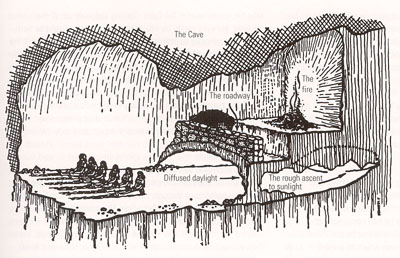Leaving the Cave: Dividing Lines
![]()
Plato uses a parable and a geometric demonstration to detach his readers form conventional assumptions. Why does Plato use a parable, followed by a geometric demonstration? Answer that question by experiencing each. To really “see” our situation in our cave requires more than speculation. To really see the relationship of squares and divided lines requires a process of discovery.
A parable is only a parable to one who lives it out. How does the Parable of the Cave work? It may be easy to understand, but difficult to practice.

Outside the cave, of course, observers can “see” chained inhabitants falsely assuming the projections they experience are “real.” The parable, however, identifies US as inhabitants, and my speculations that such may be the case cannot enable me to believe such a possibility. Perhaps the sun which illuminates and warms my world is itself merely a great fire, obscuring realities beyond, blinding me from realities unseen.
A geometric demonstration shows relationships necessary for a specific conclusion. We may believe that the following smaller squares are more or less half the size of the square surrounding them.



But the following sequence should enable you to see the true relationship of two squares: how can we see an inner square half the area of the outer square?



Begin by folding your square into quarters.
Then fold over one of the quarters as a triangle.
Now fold over a second quarter to leave two triangles.
Folding the two remaining triangles leaves a new square.
Note the four equal triangles enclosed by the inner square.
Note the four additional equal triangles outside the inner square.
The inner square is half the outer square.
Now
return to the original squares.
Can you “see” that the inner squares are half the outer squares? How?



Does this inner square look half the outer square?
Plato’s
divided line leads to one particular ratio
of lines with astonishing properties: those which appear in five-pointed
stars and pentagons.

Approach Greek Philosophy
Greek exploration, trade and colonization exposed them to alternative ways of thinking and acting. Most Athenians took pride in their open society, exercising critical attitudes towards received common sense and towards traditional cultural practices. An appreciation of conditions in which new approaches to narrative develop can enhance the reading of philosophy.